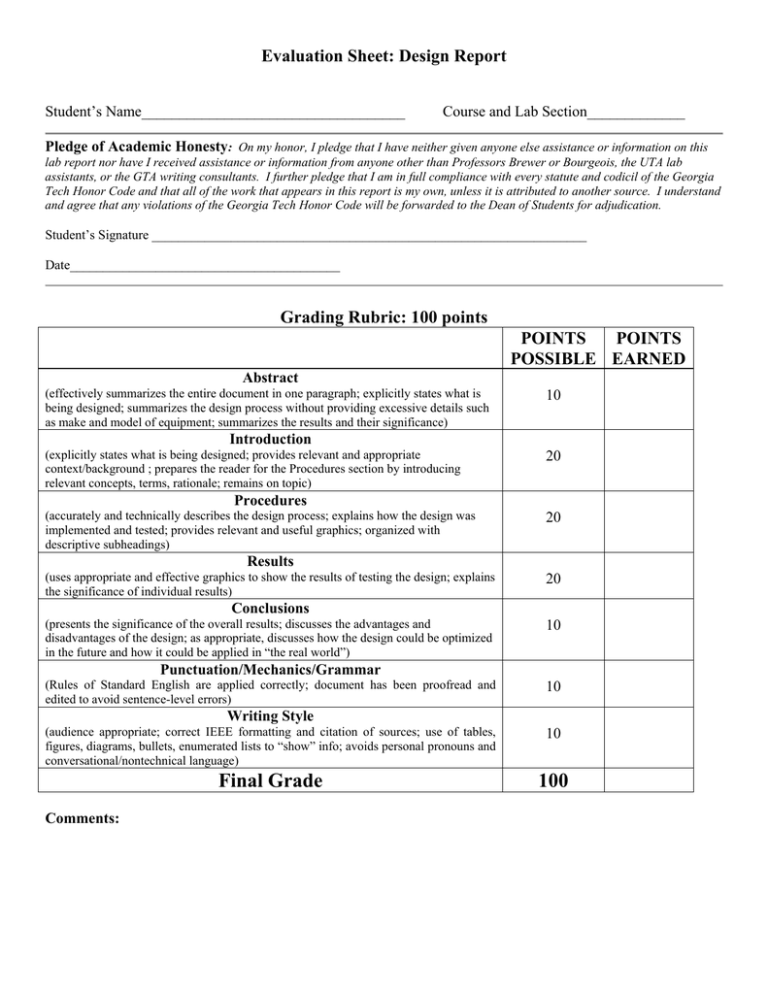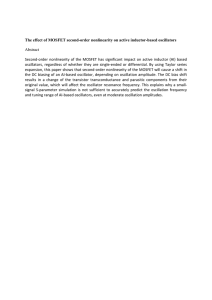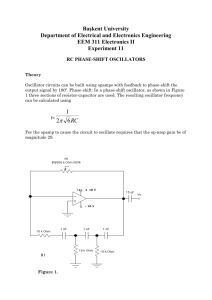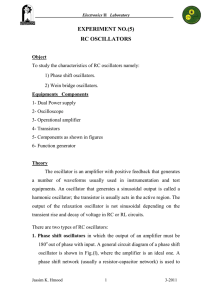Writing Assignment Spring 2013
advertisement

Evaluation Sheet: Design Report Student’s Name___________________________________ Course and Lab Section_____________ Pledge of Academic Honesty: On my honor, I pledge that I have neither given anyone else assistance or information on this lab report nor have I received assistance or information from anyone other than Professors Brewer or Bourgeois, the UTA lab assistants, or the GTA writing consultants. I further pledge that I am in full compliance with every statute and codicil of the Georgia Tech Honor Code and that all of the work that appears in this report is my own, unless it is attributed to another source. I understand and agree that any violations of the Georgia Tech Honor Code will be forwarded to the Dean of Students for adjudication. Student’s Signature __________________________________________________________________ Date_________________________________________ Grading Rubric: 100 points POINTS POINTS POSSIBLE EARNED Abstract (effectively summarizes the entire document in one paragraph; explicitly states what is being designed; summarizes the design process without providing excessive details such as make and model of equipment; summarizes the results and their significance) 10 Introduction (explicitly states what is being designed; provides relevant and appropriate context/background ; prepares the reader for the Procedures section by introducing relevant concepts, terms, rationale; remains on topic) 20 Procedures (accurately and technically describes the design process; explains how the design was implemented and tested; provides relevant and useful graphics; organized with descriptive subheadings) 20 Results (uses appropriate and effective graphics to show the results of testing the design; explains the significance of individual results) 20 Conclusions (presents the significance of the overall results; discusses the advantages and disadvantages of the design; as appropriate, discusses how the design could be optimized in the future and how it could be applied in “the real world”) 10 Punctuation/Mechanics/Grammar (Rules of Standard English are applied correctly; document has been proofread and edited to avoid sentence-level errors) 10 Writing Style (audience appropriate; correct IEEE formatting and citation of sources; use of tables, figures, diagrams, bullets, enumerated lists to “show” info; avoids personal pronouns and conversational/nontechnical language) 10 Final Grade 100 Comments: ECE 3042 Assignment Sheet Design of a Discrete BJT Phase-Shift Oscillator Due Date: Listed on the syllabus. No late papers will be accepted. Length: 10 pages maximum (body of the report). Appendix can be longer. Formatting: 1” margins, 11 point Times New Roman font, double spaced, use prescribed headings, create descriptive subheadings as needed. Getting Started: Focusing on the Obvious This experiment requires you to design, simulate, assemble, test, and evaluate a discrete phase-shift BJT common-emitter oscillator that produces a sine wave. To write an effective design report, you need to understand basic concepts: frequency, amplitude, THD of the sinusoidal waveform, where and why oscillators are used, and the difference between phase-shift and relaxation oscillators. How to Organize your Design Report 1. ABSTRACT a. Begin with an explicit purpose statement: “This document describes the design of …” (Describe the “WHAT”) b. Now explain WHY this subject is important and WHO would care about this topic. c. Briefly summarize the procedures and results. HELPFUL HINTS: Remember that the Abstract should be no more than one paragraph. It should summarize the entire document. 2. INTRODUCTION a. Start by providing the reader with an explanation of what oscillators are and where and why they are used. b. Define terms and introduce any technical concepts that are needed to understand the design. c. Clearly state what is being designed, why it is being designed, who would use the design (or where it could be applied). HELPFUL HINTS: Do not clutter the Introduction with unnecessary equations and diagrams. Only include graphics and formulas if they enhance your discussion. Avoid using them as “filler.” 3. DESIGN SPECIFICATIONS a. What criteria were used to conduct the exercises? b. What were the limitations of the design? That is, what parameters were set that you could not change or alter? These are the design specifications. c. This section can be organized with tables, bulleted information, or paragraphs. HELPFUL HINTS: The design specifications were given to you. Just copy and paste them into this section of your report. 4. PROCEDURES a. What steps did you take to design the oscillator? b. What measurements or calculations did you take while conducting this experiment? c. What equipment did you use? (Remember to name the make and model #.) HELPFUL HINTS: As you write the Procedures section, remember that your audience consists of engineers who are familiar with this material but who may not have conducted this particular experiment. Therefore, you don’t need to give details about which buttons were pressed on the oscilloscope; simply state that it was used. However, you will need to give a general overview of all the steps taken to complete the experiment. 4. RESULTS a. What are the results and outcomes? b. What is the significance of these results? c. DISCUSS, INTERPRET, EXPLAIN the individual results, demonstrating you understanding of the experiment. d. Did you compare and contrast the theoretical, the simulation, and the experimental results? e. Tabulate numerical results. HELPFUL HINTS: You will not have space in the Results section to include all of the graphs, simulations, printouts, etc. that you produced in the lab. Therefore, make good use of the Appendices. However, everything in the Appendices must be referenced in the body of the report. Don’t use the Appendices as a dumping ground. 5. CONCLUSIONS a. Attempt to look at the “big picture.” Review the purpose statement, and think about what you have learned by conducting this experiment. b. Discuss whether the design met the specifications. c. How could the design be improved? HELPFUL HINTS: The Conclusion section is not a summary of the report (that’s what the Abstract is for). Instead, it is used for analysis and discussion. Often, this is where the author suggests improvements and/or future work. Discrete BJT Phase-Shift Oscillator Objective To design, simulate, assemble, evaluate, and document a discrete NPN BJT common-emitter oscillator. Background An oscillator is a circuit that produces a periodic output signal with no input signal. The function generators used in electronics laboratories are examples of oscillators. They have many uses such as to produce signals to test other circuits and providing carrier signals for modulators and demodulators. Radio, television, cell phones, etc. wouldn’t be possible if it weren’t for oscillators. Both digital and analog electronics are used to produce oscillators; this exercise will be limited to analog circuits. There are two basic types of analog oscillators: relaxation and phase shift. This exercise will investigate a phase shift oscillator that use a BJT transistor in the common-emitter configuration to produce the gain and part of the phase shift required for oscillation. Oscillator design consists of implementing a circuit that produces a signal with a desired waveshape, frequency, amplitude and spectral purity. Phase shift oscillators are used to produce sine waves. Design parameters would consist of the frequency, amplitude, and THD of the sinusoidal waveform. If the transfer function of a linear amplifier has a gain of unity and a phase-shift of zero degrees at a particular frequency, the output could then be connected to the input and the circuit would oscillate at this frequency. This output driving the input might seem counterintutive and a violation of the conservation of energy but this is specious. The energy required to produce the sine wave is derived from the dc power supply for the circuit. For a pure sine wave the gain must be exactly one at the frequency at which the phase is zero. If the gain is less that one oscillations will die out. If it is greater than one the amplitude of the sine wave will increase until the circuit enters a nonlinear portion of its characteristic. Such oscillators are normally designed for the gain to be slightly larger than one and then filters are used to remove the nonlinearity in the output waveform. Fig. 1. Discrete Phase-Shift Oscillator Shown in Fig. 1 is a discrete phase shift oscillator. Feedback exists from the collector node through the RC sections back to the base node. It uses a single common-emitter stage to produce a certain gain and a phase shift of 180◦ The three RC high-pass sections produce an additional phase sift of 180◦ and attenuation so that this circuit is capable of driving itself or oscillating. The gain is controlled by the resistor 2 . If the gain is too small any oscillations are quickly damped out. If the gain is too high the output (taken at the collector node) distorts. The distortion may be removed by following this circuit with a filter. The filter must removed the dc collector voltage and the high frequency distortion components, viz. a high Q bandpass filter. In order to analyze the circuit a model is needed for the transistor. It will be assumed that small-signal conditions exists (no cutoff or saturation) and that the frequencies of question are the midband frequencies for which is a short circuit. The hybrid pi model will used shown in Fig. 2. Fig. 2. Hybrid Pi Model of BJT The parameter = 0 is known as the base spreading resistance which affects primarily the high frequency response. This is a simplified model which does not model the Early effect. The parameter = ( + 1) where = is the transistor current gain or forward beta and = is the intrinsic emitter resistance with the thermal voltage which can be taken to be 26 mVThe SPICE parameters for these parameters are RBBF, and VA for the base spreading resistance, forward beta, and Early voltage. Inserting the hybrid pi model for the BJT into the circuit of Fig. 1, the small signal oscillator can be reduced to Fig. 3. Small Signal Model of Phase Sift Oscillator where it has been assume that the parallel combination of the base bias resistor 1 and 2 is so large that they may be omitted. Also the resistor 1 has been selected to satisfy 1 = − where is the small signal input impedance seen looking into the base of the transistor = + ( + 1) [ + ] where is the Thevenin equivalent resistance seen looking out of the emitter of the transistor = 1 k 2 Mesh analysis of the circuit in Fig. 3 yields ⎤⎡ ⎤ ⎡ 1 − 0 2 + 1 ⎦ ⎣ 1 ⎦ = 0 ⎣ − 2 + − 1 2 − + + where the three mesh currents are shown in Fig. 3. Because the right hand side of the above equation is zero, the three mesh currents will be zero unless the determinant of the impedance matrix is zero. So the conditions necessary for oscillation to occur is the determinant must be zero. This means 22 + 1 32 ( + ) + + 4 ( + ) + 2 2 + 4 2 2 + 3 3 − 23 + 2 = 0 Setting = and setting the real and imaginary parts seperately equal to zero will yield two equations. The imaginary yields 1 1 √ = 2 2 6 + 4 as the frequency of oscillation and the real component yields +4 ≥ 23 + 29 as the condition necessary for oscillation to occur. Design Specifications Design a discrete phase shift oscillator that produces a sine wave with the following specifications: • frequency, equal to the experimenter’s birthdate in kHz for experiments born prior to July 1 and half the experimenter’s birthdate in kHz for experimenters born on or after July 1 • dc level less than 250 mV • peak-to-peak voltage 5 V • THD less than 10% Recomended Procedure • Select a value for the dc collector current. A logical value would be the value that produces symmetric clipping for a common emitter amplifier. Select a value for 1 1 , and 2 that will produce the desired value of collector current. The base bias resistors 1 and 2 should be large. Since the current that produces symmetric clipping depends on the resistors that sets the current, some approximations need to be made to obtain a starting point. • Pick values for and that produce the desired frequency of oscillation 1 1 √ = 2 2 6 + 4 • Measure or assume that it is at least 100 Determine whether the relationship +4 ≥ 23 + 29 is satisfied. • Select the resistor 1 using where 1 = − = + ( + 1) [ + ] and for the design calculations assume that the base spreading resistance, = 0. • Perform a SPICE simulation using either National Instruments SPICE, Multisim. Appropriate analyses are dc operating point and transient. Set the parameters for the SPICE analysis so that at least two cycles are displayed. Tweak the design until the desired frequency of oscillation is obtained. The output node is the collector voltage. Observe the effect of varying the resistor 2 • A bandpass filter can be used to removed the dc level from the signal and high frequency harmonics which distort the output. An op amp BPF is acceptable. Add it to the SPICE simulation. Determine the output level and output dc offset as well as the THD. • Assemble the circuit in lab using a 2N3904 NPN BJT and for the BPF either a 741 or TL071 may be used. • Measure the output in the time and frequency domain with the oscilloscope. It it meets specifications, print the screen of the oscilloscope. Report Prepare the report using the specified format. Include all calculations, computer simulations, and experimental data taken. Discuss whether the design met the specifications and suggest improvements.




